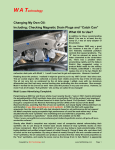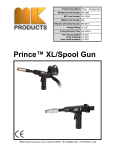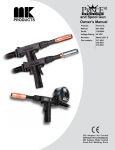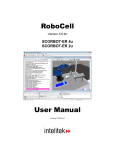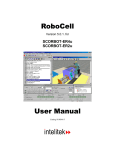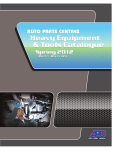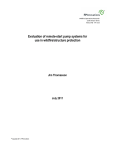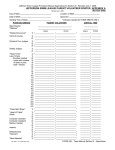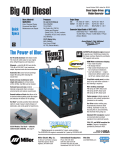Download 7 - WA Technology
Transcript
W A Technology Replacing C6 Corvette Coolant GM recommends the coolant be replaced after 5 years or 150,000 miles whichever occurs first. In a C6 it straight forward so there is no reason not to do it on or before that time. With only 18,000 miles on the 2008 Vette but 4 ½ years it was time. The cooling system has never been a problem and the temperature always in the correct range. Tools Required: Other than a pair of pliers to help remove the drain plug (it’s plastic in plastic so not difficult) and the proper jack there are no special tools - assuming you do not need to use a “flush procedure” (see below.) Is a Flush Needed? The GM Service Manual recommends looking at the coolant and “If Normal in Appearance” use what they call the “Filling Procedure.” If it is “Discolored” the recommendation is to use a “Flush Procedure.” Although both will be mentioned below, our fluid looked exactly like the new coolant purchased so only the “Fill Procedure” was used. The first pictures in the following outline will discuss the filling procedure used. We followed this procedure and unlike what we normally have done and do in our Street Rod, which is to fill a drained system with plain water, run the car with the heater set on high, drain the remaining mixture of water and coolant then repeat several times, we just followed GM’s recommendation. Since the coolant looked brand new and there was hardly any residual in the Coolant Tank, we felt the procedure was fine. After the first photos and text covering the “Fill Procedure,” the GM “Flush Procedure” is presented. NOTE: The Service Manual has a statement which says IMPORTANT: Do not use a chemical flush! Therefore a flush procedure does not mean you need to buy any flush product! The flushing procedure just uses a water fill a number of times to get the full system free from old coolant. It also recommends removing and cleaning the Coolant Tank (also called a Surge Tank.) Several pictures will show how that is done. This is a procedure we would normally use but it will require more new coolant. We’ll explain, although the GM Service Manual does not and in fact is incorrect! Copyright by WA Technology, LLC www.NetWelding.com Page 1 Photo Sequence The passenger side of Corvette will need to be raised to gain easy access to the radiator drain plug on the lower passenger side of the radiator. I recommend buying some jack pads. The red aluminum one shown was purchased as a set of 4 and fit into four slots in the floor under the frame rail in locations that can be used as a jacking points. They just slip in the slot and with a ¼ twist stay in place. You do not have to lift very high for this task as the drain plug can be accessed from the front of the car by reaching in with your hand. The aluminum racing jack pictured has a very low profile allowing plenty of room to fit under the jack pad. Harbor Freight often has these on sale for under $60.00. Place a wheel chock behind the driver’s rear wheel before jacking to prevent the car from moving backward. Even though the front passenger wheel need not be raised more than about 4 inches and you do not have to go under the car for any distance, placing a 4 inch piece of wood under the tire should provide the security needed. Place about a 3 gallon shallow container below the hole visible under the drain plug. It will have to hold about 2 gallons of drained coolant. Turn the drain plug (yellow in sketch left) counterclockwise about 3 or 4 turns. It may be possible to start by hand but I used a pair of pliers to help. The coolant will drain for about 20 minutes after removing the cap on the coolant tank (see tank below.) Fully remove drain plug and lubricate the “O” ring at the end with clean coolant. Insert and tighten the drain plug to 18 in-lbs. (slightly more than hand tight, I snugged a little with pliers.) Copyright by WA Technology, LLC www.NetWelding.com Page 2 Use a quality coolant like this one from Prestone meeting GM Dex-Cool specifications. Don’t consider anything else! There was a $7.00 rebate offer from Prestone and Walmart’s price was $14.95 for the gallon. If following the GM recommend ‘filling procedure” there will be one gallon of 50/50 mixture left in the engine. However, as mentioned, the coolant removed looked new! When filling I also used a gallon of distilled water. Distilled water probably wasn’t necessary but I did not want to trust tap water and for $1/gallon the distilled water is a safer choice! Fill the Coolant Tank with a 50/50 mixture of Coolant Concentrate and Water. I filled alternately with equal measured amounts of both from a small container. 1. After the first Tank fill to just below the bottom of the fill tube idle the engine for 4 minutes. I shut off the engine after about 3 minutes and filled the now empty Tank again. You can buy as a 50/50 premix but it was only $2/gallon less than the concentrate so the $1/gallon of distilled water was the way to go. 2. Run the engine this time for about two minutes at 2000-2500 rpm. Tank will empty. Although not mentioned, I did this twice. Follow the procedure outlined on the right. 3. GM recommends filling the empty Coolant Tank with 1 quart of coolant and monitoring. I used somewhat more and found in the morning it needed about 20 to 25 ounces more. Will monitor after several cycles after driving and cooling. GM Fill Suggestion: Note; If using the GM “Flush Procedure” you will only be able to use Concentrated Coolant. See last part of that procedure for an explanation as to why. Flush Procedure 1. Drain as in the “Fill Procedure” and install drain plug hand tight. 2. Next remove the Coolant Tank (green picture right) by first: a) Relieve the tension on the top inlet hose (green)and remove hose. Copyright by WA Technology, LLC www.NetWelding.com Page 3 b) Relieve the tension on the bottom outlet hose (green) and remove hose. c) Then: 1. Remove the protective cap on the Coolant Tank top stud and remove the nut. 2. Loosen the Tank side nut. 3. Remove Coolant Tank. 4. Clean the tank with only clean water-not chemicals. (Maybe using a hose spray would help?) 5. Install Coolant Tank and lubricate hoses with clean coolant when installing. Fill system as in “Fill Procedure” in steps above but with plain water. Important Note: When finally filling the system with new coolant, there will be about 1 gallon of just water left in the engine. Therefor you will need to add 1 gallon of concentrated coolant to make the mixture 50/50 (the GM Service manual does not mention that!) Then fill the remainder with a 50/50 mixture. The system capacity is 12.5 quarts and we drained only 2 gallons (8 quarts) therefore about 1 gallon of water will be left in the system when the flush procedure is followed. Might want to check the final mixture with a hydrometer and correct as needed before completely filling. Should need about 1 ½ gallons of coolant concentrate. Copyright by WA Technology, LLC . 1. Run engine for 20 minutes. 2. Stop engine, allow it to cool (my precaution) and drain water/residual coolant in system. 3. Repeat the only water fill and steps 1 and 2 above until the water runs clear. 4. Since you are mixing water with about a gallon of coolant (system holds about 3 gallons) this will take a number of repeats to have the water “nearly colorless” as suggested by GM. 5. When in drains clear; Lubricate drain plug and fill as in Fill Procedure after reading the note at left about amount of coolant concentrate to add first! www.NetWelding.com Page 4 W A Technology Advertisement Have a MIG Welder? Have a Friend with One? Or Know Someone with a Fabrication Shop? Do yourself or them a big favor and review this information. Our Patented Gas Saver System (GSS TM) Cuts Shielding Gas Use In Half Or More By Reducing Waste - It Also Improves Weld Start Quality. This schematic helps show why there is a high gas surge flow at each weld start. Shielding gas pressure and gas volume builds in the gas delivery hose every time welding stops. The pressure drops across the needle valve or orifice flow control to only 3 to 5 psi (Pfd) in the gas hose while welding. The gas hose pressure increases to the regulator pressure of up to 80 psi when welding stops. When welding starts, the extra stored gas (up to 7 times the physical hose volume) blasts out of the MIG gun nozzle until flow reaches the preset rate. The high gas surge at the start not only wastes gas but also pulls air into the shielding gas stream. This air makes inferior weld starts with excess spatter and possibly internal if not visible weld porosity. Our patented Gas Saver System solves both problems by limiting the volume of extra gas stored when welding stops and using a flow control restrictor to limit maximum peak surge flow rate. With thousands in use, some commercial fabricators have saved over 60% in total gas use! A small shop or home user could save even more since they make many short and tack welds. The more often the MIG gun switch is pulled the more gas is wasted and the more our GSS can save! Our Patented Product Is Available on Our Web Site. Copyright by WA Technology, LLC See Products at www.NetWelding.com Advertisement CUSTOMER TESTIMONIALS Perry Thomasson Purchased a 50 foot Gas Saver System ( GSS TM ) For His Home Shop Perry has a very well equipped home shop. For a MIG welder he uses a Millermatic 175. However the small welder cart only held a medium size shielding gas cylinder and he wanted to reduce the number of times he had to have it filled. He purchased the largest cylinder his distributor offered for sale and chained it to a wall in his shop. He needed a much longer gas delivery hose so he added a 50 foot conventional 1/4 inch ID hose. He found he was using a great deal of gas. He bought our patented Gas Saver System TM (GSS ) and saved a significant amount of shielding gas while improving his weld starts by reducing the starting gas surge. Since his regulator/flowgauge had a hose barb on the output he used a splice connector we supplied him with the GSS (See Photo Right.) Perry emailed these pictures and said; " The system works great. Thanks for the professional service and a great product." Perry’s brother recently purchased a similar GSS for his home MIG welder. A Professional Street Rod Builder Had This to Say: They use a 250 amp MIG welder with built in feeder and a 6 foot gas delivery hose. With their standard gas delivery hose the peak shielding flow at weld start was measured at 150 CFH, far more than needed and enough to pull air into the shielding stream. Air is then sucked into the gas stream causing poor weld starts and possibly weld porosity. With the GSS replacing their existing hose, the peak flow surge at the weld start was under 50 CFH. With the many short welds made and frequent inching of the wire, they used less than half the gas and had better starts. Kyle Bond indicated a big benefit is the reduced time and effort changing cylinders since it’s required less frequently. He quickly saw the improvement achieved in weld start quality as a significant advantage! Kyle, an excellent automotive painter, was well aware of the effects of gas surge caused by pressure buildup in the delivery hose when stopped. He has to deal with the visible effects in the air hose lines on the spray gun in his paint booth! It's too bad we can't see the shielding gas waste as Kyle can the effects of excess pressure when he triggers his spray gun! The paint surge is visible and creates defects unless the gun is triggered off the part being painted! Kyle can manage the surge by triggering the paint gun off the part; unfortunately we can’t start our weld with the MIG gun off the part! The GSS has a built in surge flow limiting orifice that keeps the peak flow from becoming excessive. So you not only save gas you improve your weld starts! Copyright by WA Technology, LLC See Products at www.NetWelding.com






